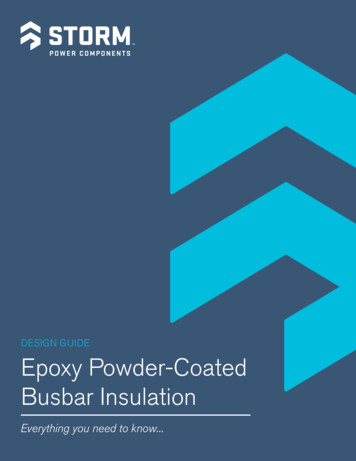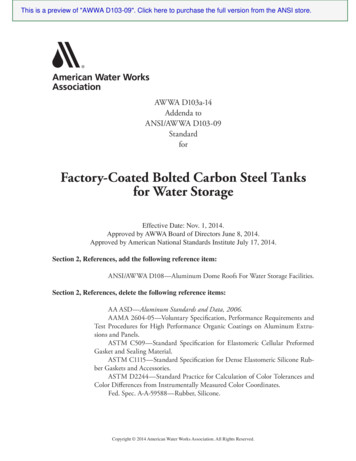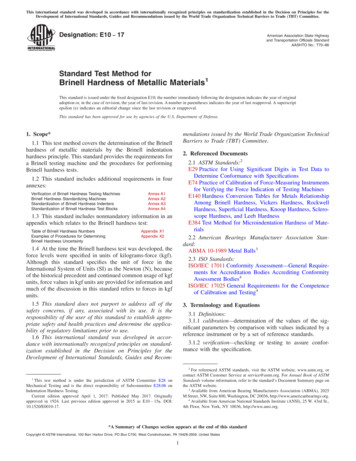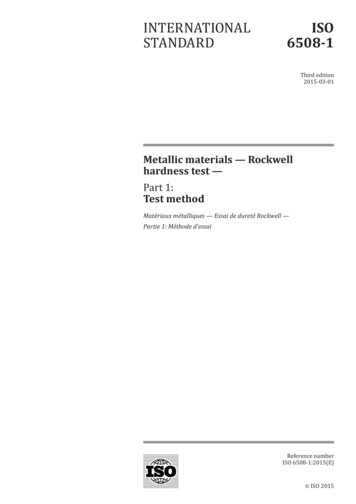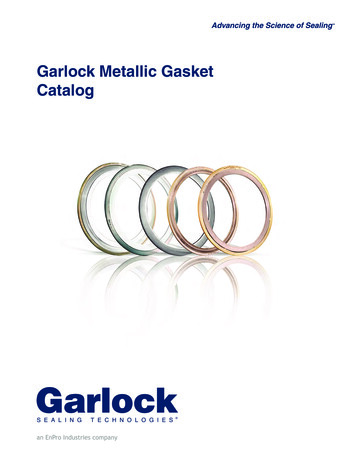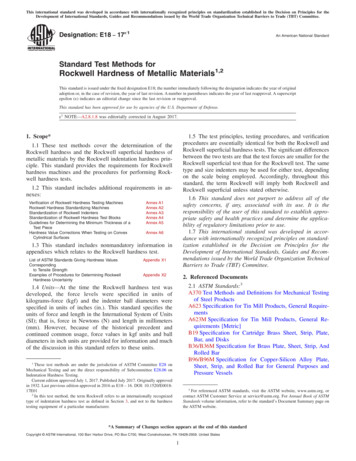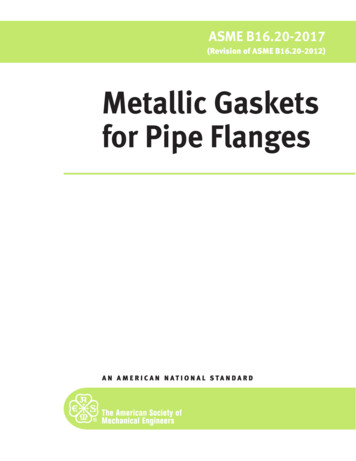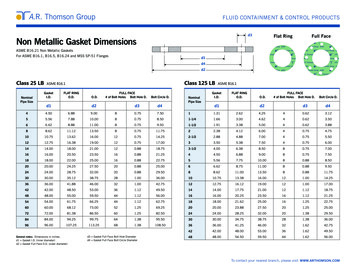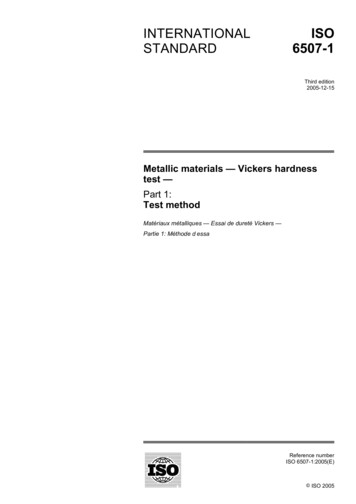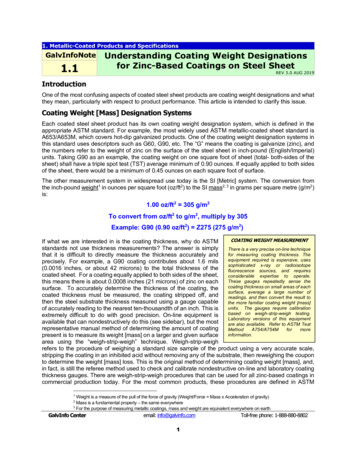
Transcription
1. Metallic-Coated Products and SpecificationsGalvInfoNote1.1Understanding Coating Weight Designationsfor Zinc-Based Coatings on Steel SheetREV 3.0 AUG 2019IntroductionOne of the most confusing aspects of coated steel sheet products are coating weight designations and whatthey mean, particularly with respect to product performance. This article is intended to clarify this issue.Coating Weight [Mass] Designation SystemsEach coated steel sheet product has its own coating weight designation system, which is defined in theappropriate ASTM standard. For example, the most widely used ASTM metallic-coated sheet standard isA653/A653M, which covers hot-dip galvanized products. One of the coating weight designation systems inthis standard uses descriptors such as G60, G90, etc. The “G” means the coating is galvanize (zinc), andthe numbers refer to the weight of zinc on the surface of the steel sheet in inch-pound (English/Imperial)units. Taking G90 as an example, the coating weight on one square foot of sheet (total- both-sides of thesheet) shall have a triple spot test (TST) average minimum of 0.90 ounces. If equally applied to both sidesof the sheet, there would be a minimum of 0.45 ounces on each square foot of surface.The other measurement system in widespread use today is the SI [Metric] system. The conversion fromthe inch-pound weight1 in ounces per square foot (oz/ft2) to the SI mass2, 3 in grams per square metre (g/m2)is:1.00 oz/ft2 305 g/m2To convert from oz/ft2 to g/m2, multiply by 305Example: G90 (0.90 oz/ft2) Z275 (275 g/m2)COATING WEIGHT MEASUREMENTIf what we are interested in is the coating thickness, why do ASTMstandards not use thickness measurements? The answer is simplyThere is a very precise on-line techniquefor measuring coating thickness. Thethat it is difficult to directly measure the thickness accurately andequipment required is expensive, usesprecisely. For example, a G90 coating contributes about 1.6 milssophisticated x-ray or radioisotope(0.0016 inches, or about 42 microns) to the total thickness of thefluorescence sources, and requirescoated sheet. For a coating equally applied to both sides of the sheet,considerable expertise to operate.These gauges repeatedly sense thethis means there is about 0.0008 inches (21 microns) of zinc on eachcoating thickness on small areas of eachsurface. To accurately determine the thickness of the coating, thesurface, average a large number ofcoated thickness must be measured, the coating stripped off, andreadings, and then convert the result tothen the steel substrate thickness measured using a gauge capablethe more familiar coating weight [mass]units. The gauges require calibrationof accurately reading to the nearest ten-thousandth of an inch. This isbased on weigh-strip-weigh testing.extremely difficult to do with good precision. On-line equipment isLaboratory versions of this equipmentavailable that can nondestructively do this (see sidebar), but the mostare also available. Refer to ASTM Testrepresentative manual method of determining the amount of coatingMethodA754/A754Mformoreinformation.present is to measure its weight [mass] on a larger and given surfacearea using the “weigh-strip-weigh” technique. Weigh-strip-weighrefers to the procedure of weighing a standard size sample of the product using a very accurate scale,stripping the coating in an inhibited acid without removing any of the substrate, then reweighing the couponto determine the weight [mass] loss. This is the original method of determining coating weight [mass], and,in fact, is still the referee method used to check and calibrate nondestructive on-line and laboratory coatingthickness gauges. There are weigh-strip-weigh procedures that can be used for all zinc-based coatings incommercial production today. For the most common products, these procedures are defined in ASTM1Weight is a measure of the pull of the force of gravity (Weight/Force Mass x Acceleration of gravity)Mass is a fundamental property – the same everywhere3For the purpose of measuring metallic coatings, mass and weight are equivalent everywhere on earth2GalvInfo Centeremail: info@galvinfo.com1Toll-free phone: 1-888-880-8802
GalvInfoNote 1.1REV 3.0 AUG 2019Standard A90/A90M, and cover galvanized and galvannealed sheet, 55% aluminum-zinc alloy-coatedsheet, zinc-5% aluminum alloy-coated sheet, and zinc-aluminum-magnesium alloy-coated sheet. There arespecial procedures required for other types of alloy coatings such as aluminized, and zinc-nickel alloyelectroplated sheet. These are covered by other ASTM standards.Coating Weight and Gauge Numbers – In the BeginningIn the early days of galvanizing, individual sheets were “hand dipped” in molten zinc and allowed to “drip dry”. Moresophisticated wiping technology was not available, so zinc coatings were much thicker than today. Galvanized sheet wassold by weight per square foot using the Galvanized Sheet Gauge (CSG) system1. The decimal thicknesses in the GSGsystem were equal to the steel sheet Manufacturers’ Standard Gauge (MSG), but with a 0.0037” allowance for a relativelythick zinc coating of 1.25 oz/ft2 on each surface. The gauge numbers did not refer to only one thickness, but insteadrepresented a thickness range within the allowable weight tolerance for each gauge number.The 1.25 oz coating on hand dipped sheets was sometimes not very adherent because of its thickness and chemistry,limiting application to end uses that involved only mild forming. Such a thick coating was much more than was neededfor most applications, plus the zinc cost was an appreciable portion of the sheet selling price, especially for thin sheet. Inthe 1930s the sheet galvanizing process began migrating to the continuous method with its higher production rate andimproved wiping methods. At the processing speeds used it was, and still is, very difficult to successfully apply 1.25ounces of zinc on each surface of thin sheet. At about the same time, the industry learned that a small amount of aluminumin the zinc bath markedly improved zinc adhesion. Manufacturers saw an opportunity, so began producing coated sheetwith lower coating weights, which reduced production costs, resulted in a much more formable coating, yet providedadequate corrosion protection for the markets that did not need thick coatings.The most common of the original thinner coatings was labeled “1.25 Commercial”, which aimed at minimum 0.90 oz/ft2,split between both sides. In 1964 such coatings were formally standardized in ASTM specification A525 GeneralRequirements for Steel Sheet, Zinc-Coated (Galvanized) by the Hot-Dip Process. Coating Class “1.25 Commercial”became Coating Designation “G90”, with a specified minimum weight of 0.90 oz/ft2, total both sides. The coating classknown as “Light Commercial” became Coating Designation “G60”. Coating Class “2.50” (equivalent to the original1.25 per side coating) became Coating Designation “G210”.The above short history explains the origin and meaning of “1.25 Commercial” coating, which even today is occasionallyreferred to in the marketplace, as are gauge numbers. It is important to remember that “1.25 Commercial” has not existedsince the late 1950s, and that gauge numbers were never regulated and did not refer to only one thickness, but instead toa range of thicknesses.1Steel Sheet Facts 10, Steel Gauges and Thicknesses, Canadian Steel Sheet Building Institute, September 2012,http://cssbi.ca/assets/resources/Fact Sheets/CSSBI-Facts10-12.pdfASTM Coating Designations – What do they specify? ASTM designations for hot-dip coated sheet specify:– Minimum triple spot test (TST) value Average of three edge-center-edge readings A total-both-sides (TBS) requirement (See A924/A924M for testing details)– Minimum single spot test (SST) value A single spot TBS requirement, and– Minimum single side requirement Is normally not less than 40 % of the SST, TBS requirementThe TST test only applies to the original, full-width (as-coated) sheetGalvInfo Centeremail: info@galvinfo.com2Toll-free phone: 1-888-880-8802
GalvInfoNote 1.1REV 3.0 AUG 2019 Narrow sheet cut from full-width sheet is subject only to a minimum SST, TBS requirementWith the exception of supplementary Table S2.1 in A653/A653M, ASTM specifications state thatthe minimum weight on one side of a single spot test is normally not less than 40 % of the totalboth-sides requirementExamples of full-width pass/fail test results for A653 are given belowTable 1 Example G90 Coating Weight Results - Illustrating Passing and Failing the Requirementsof A653/A653M (Table 1) – values in oz/ft2Requirements of A653 (Table 1):Minimum Triple Spot Test average (TST), Total Both Sides (TBS) – 0.90 oz/ft2Minimum Single Spot Test (SST), Total Both Sides (TBS) – 0.80 oz/ft2Single Spot Test (SST) ‘normally not less than’ 0.32 oz/ft2 on any one side (per Footnote A of A653 Table Passes min TST-TBS2TBS0.850.930.960.91Passes min TST-TBS3TBS0.850.870.960.89Fails on min TST-TBS4TBS0.780.950.960.90Fails on min 50.940.9550.91Passes on min TST-TBSReview Low OS-Top value1This value is marginally below the aim of ‘normally not less than’ 40 % (0.32 oz/ft2) of the SST-TBS value of 0.80 oz/ft2 onany one side of a G90 SST. Production coating weight [mass] data should be reviewed to determine if there is a need forretesting before the product is approved.Designation System for Galvanized and Galvannealed Sheet ProductsGalvanize – For galvanized sheet, common inch-pound coating weight designations (ordered as A653 orA1063) are, in oz/ft2:G30G40G60G90G115These designations specify the minimum average TST, total-both-sides, tested per ASTM A924/A924M,e.g., G90 requires a minimum average TST of 0.90 oz/ft2 total-both-sides. The specification stipulates thatTST samples shall be taken from defined positions at the edge-center-edge of the as-coated sheet.There are designations for heavier coatings, such as G165 and G210, which are used for very specializedapplications and are generally not available on thinner gauge sheet.In SI units (ordered as A653M or A1063M), the comparable coating mass designations for galvanized sheetare, in g/m2:Z90Z120Z180Z275Z350These designations specify the minimum average TST, total-both-sides, tested per A924/A924M, e.g., Z275requires a minimum average TST of 275 g/m2 total-both-sides.In 2007 ASTM added the option of ordering single side, single spot test (SST) coating designations toA653/A653M. These are SI designations only (ordered to A653M) and specify the minimum and maximumallowable coating mass per side for any SST. They take the familiar form of automotive coatingdesignations (numeric characters first – signifying a per side requirement). Inch-pound designations arenot used since single side coatings are traditionally ordered in SI units only.GalvInfo Centeremail: info@galvinfo.com3Toll-free phone: 1-888-880-8802
GalvInfoNote 1.1REV 3.0 AUG 2019Examples are:60G70G90GThese designations specify the minimum and maximum SST value on each surface, e.g., 60G requires aminimum of 60 g/m2 and a maximum of 110 g/m2 of zinc on each surface for any SST.When specifying single side single spot coatings, the designation for each surface must be shown, e.g.,60G60G.Coating weight [mass] versus coating life – For galvanized coatings in most applicationsand environments, the corrosion performance is an approximate linear function of coatingweight (thickness). For instance, a G60 coating has twice the thickness of a G30 coating, andthe life of the product (defined, perhaps, as the time to 5% red rust) in a given environment isapproximately twice as long. Similarly, a G90 coating is approximately 50% thicker than a G60coating, and thus would be expected to perform 50% better (in terms of time to 5% red rust).For a more thorough discussion on service life, see GalvInfoNote 3.1. Limits on maximumacceptable coating weights for an application are usually determined by other factors such ascost or formability. For a more thorough discussion of this topic see GalvInfoNotes 1.6 and 2.5.For other metallic-coated sheet products, the life versus coating thickness is typically not linear;thus determining the coating weight [mass] to use is not as simple as it is for galvanizedcoatings. Also, when these products are painted, the behaviour is even more complex. Thesubject of painted hot-dip products is addressed in GalvInfoNotes 4.1 and 4.2.Zinc-Iron (Galvanneal) – The common inch-pound coating weight designations (ordered as A653) forgalvannealed sheet (zinc-iron alloy-coated) are, in oz/ft2:A25A40A60As with galvanized product designators, A40 for example, requires a minimum average TST coating weightof 0.40 oz/ft2, total-both-sides. While the coating contains approximately 8 to 10% iron, resulting in thedensity being slightly higher than a zinc coating and the coating thickness being slightly less than a G40galvanize coating, the difference is too small to be of concern. The effect of density is discussed in thesection on 55% Al-Zn coatings, and in GalvInfoNote 1.10. Also, see GalvInfoNote 1.3 for a full explanationof hot-dip galvanneal coatings.The SI equivalent coating mass designations (ordered as A653M) for galvannealed sheet are, in g/m2:ZF75ZF120ZF180ZF120, for example, requires a minimum average TST of 120 g/m2 total-both-sides.As with galvanize, the option of ordering zinc-iron coatings to single side, SST coating designations hasbeen added to A653/A653M. Again, these are SI designations only (ordered to A653M), specifying theminimum and maximum allowable coating mass per side for any single spot, and taking the familiar form ofautomotive coating designations (numeric characters first – signifying a per side requirement). Again, inchpound designations are not used since single side coatings are traditionally ordered in SI units only.Examples are:45A50AThese designations relate to the
appropriate ASTM standard. For example, the most widely used ASTM metallic-coated sheet standard is A653/A653M, which covers hot-dip galvanized products. One of the coating weight designation systems in this standard uses descriptors such as G60, G90, etc. The “G” means the coating is galvanize (zinc), and the numbers refer to the weight of zinc on the surface of the steel sheet in inch .
